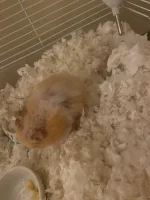Thank you for explaining all that - that makes some sense

If your hamster is hard to handle and there is something else that will; do the job. I actually think vets are a bit casual about prescribing invermectin in the Uk sometimes. I'm not sure of the dose myself but for a Robo I had, the dose was two drops on the back of the neck, just once, then repeat a week later and that was it. But for a Syrian it would be a bigger dose and maybe difficult to get right if she wriggles a lot, yes. And Invermectin is toxic if overdosed. It could take swaddling or scruffing a wriggly hamster, to apply the correct dosage. But it is anti parasitic. I assume the vet knows if the other treatment was suitable for demodex mites or not though.
Going back to her cage - if she does have mites then it may be that your clean out wasn't a full one, - so it's possible they started up again.
I'm not convinced that apple cider vinegar would be enough to kill demodex mites. It is usually a heat above a certain temperature that kills the mites and eggs, or certain types of disinfectant (hamster safe disinfectant). In the same way, white vinegar will kill some bacteria but not all and is more of a cleaner than a disinfectant.
It is hard to know what stage things are at, but if she didn't have a complete full cage clean before then it's possible she has got mites back again from something in the cage. On the other hand if you do a full cage clean now, and the treatment isn't working as she got them back again ......
It's difficult. Do you have a spare cage? I'm wondering if you should set up a spare cage with new bedding and bake or disinfect any current items to put in it and see how she goes in that. Alternatively do a full cage clean now - it's so hard and unfair but once it's over you know everything is done. So to ensure the cage is mite free, everything needs removing, The enclosure itself cleaned out with a small animal-safe disinfectant - maybe F10 or similar - but don't use bleach. Making sure you get it into any corners and crevices - is it a glass tank or a wood enclosure? Does it have a wood or metal lid? That needs spraying with disinfectant too.
Then all new bedding. Ceramic or plastic items can just be cleaned with the disinfectant. Wood items can be baked at 100 degrees centigrade. But as you say, anything with metal can't really be baked. Do you have a photo of the bridge? I can't imagine one with metal ends

I have a couple and
I'm not entirely sure how they're held together. But if they have metal inside .........
It would be a shame to throw it away when they're not cheap, but I wouldn't re-use it for now. You could maybe soak it in disinfectant and then rinse it and leave it to dry and put it away somewhere? I would probably throw it personally but then I'd be a bit paranoid about them coming back! Having had moth outbreaks myself. With tiny microscopic mites and eggs they can be tucked away in the tiniest of crevices.
With my wood house I sprayed disinfectant well into the corners and joints. It didn't fall apart! That was smooth wood though, not rough wood.
Anyway if you do have a spare cage, she will need to go somewhere while you do the full cage clean - unless you can get it done in a day and then she could just go in a pet carrier for the day and sleep in it.
It does sound as if either the treatment isn't working, if they've come back, and it was diagnosed as mites in the first place, or they were still in the cage and came back and the treatment wasn't enough to prevent that - I think it takes both at the same time.
So it's tricky at the moment. If you do the full cage clean now and the treatment isn't working, it will need doing again as the mites will get from her to the cage contents again and vice versa.
I think I would be tempted to be asking for more mite treatment now and give it will she's out of the cage in the temporary enclosure, while you do a full cage clean the first day.
Is there something else you could use instead of the bridge? I had to throw away a lot of items once and replaced them mainly with cardboard and ceramic items for a while, that could easily be replaced or disinfected. How is she climbing to the top? Is it a barred cage?
If you have a photo of her cage, it might help suggest something. Barred cages can be a pig to disinfect!
When I had a moth outbreak, it was getting rid of the eggs that was the main issue (not visible to the naked eye) and my vet recommended soaking the cage in a bath of beaphar disinfectant. That wasn't actually possible because the cage wouldn't fit in the bath and it would have taken a ton of disinfectant, so I sprayed it thoroughly, making sure the bars were full covered all the way round and in all the corners, left it on for a while then rinsed it off with water with a shower head. It seemed to do the trick!
I have to say though that Invermectin is the standard treatment for mites. People can actually buy it online, but it's not really recommended to do that and better to get it prescribed by a vet in the correct dosage.




